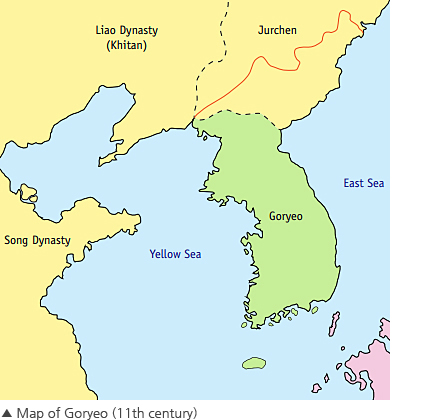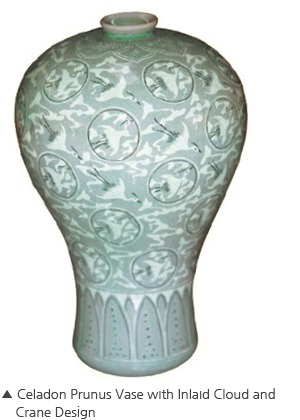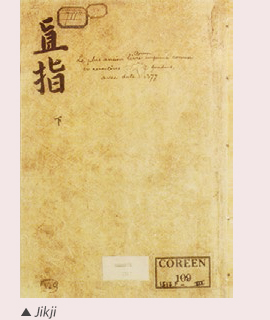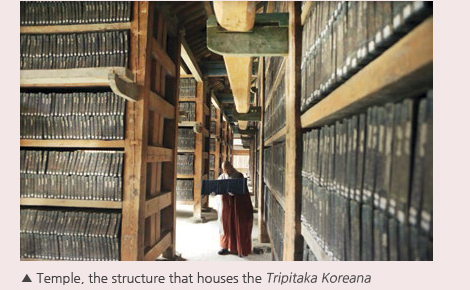Culture Focus
Korea in the World
History before 1945: Goryeo Dynasty
 |
Goryeo DynastyThe Goryeo Dynasty was founded in 918 CE and came to power in 935 CE after its army defeated its rivals and absorbed what remained of Silla Kingdom. Goryeo Dynasty was an aristocratic society where royal and noble houses monopolized government positions, land, and knowledge. The aristocracy preserved its privileged position through marriage, a protected appointment system that secured official posts for their offspring, and exemptions from paying taxes and labor duties.Goryeo Dynasty adopted Buddhism as its state religion to an even greater extent than Silla Kingdom. Praying for the security of the nation and hoping to ward off foreign invaders, many excellent Buddhist works of art were produced during this period. Many world-class Buddhist paintings, celadons, and other masterpieces survive today both in Korea and overseas. |
The world’s first book known to have been printed with metal movable type was published in the Goryeo Dynasty in 1234. This was some two hundred years before Gutenberg invented metal movable type in Europe. Jikji, the world’s oldest surviving book printed with metal movable type in 1377, now on exhibit at the National Library of France, was also found in Korea. The United States Library of Congress houses some specimens of Korean metal movable type assumed to have been created in the earliest years.
Korea’s advanced printing technology dates back to the Unified Silla Kingdom. The oldest extant woodblock print in the world is a Buddhist scroll that was created during the Unified Silla Kingdom period. It is known as the Great Dharani Sutra. Published in the eighth century, it was found in a Buddhist temple pagoda. Korea’s advanced woodblock printing culminated in the production of the Tripitaka Koreana in the 13th century, a compilation of Buddhist doctrines and commentaries by great monks carved on woodblocks. Now recognized on the UNESCO World Cultural Heritage list, it is the world’s foremost representation of Buddhist cultural heritage in terms of integrity and scale.
Korea’s advanced printing technology dates back to the Unified Silla Kingdom. The oldest extant woodblock print in the world is a Buddhist scroll that was created during the Unified Silla Kingdom period. It is known as the Great Dharani Sutra. Published in the eighth century, it was found in a Buddhist temple pagoda. Korea’s advanced woodblock printing culminated in the production of the Tripitaka Koreana in the 13th century, a compilation of Buddhist doctrines and commentaries by great monks carved on woodblocks. Now recognized on the UNESCO World Cultural Heritage list, it is the world’s foremost representation of Buddhist cultural heritage in terms of integrity and scale.
 |
Bluish-grey colored celadons from the Goryeo period are treasured pieces in the world of ceramics. The Goryeo potters improved upon the celadon brought from China and created the unique green color of Goryeo celadon. In addition, potters in the Goryeo Dynasty applied an inlay technique (a method that involves cutting patterns into the surface of a material such as metal, pottery, or wood and filling them with other materials like gold and silver) to celadon for the first time in world history to develop original inlaid celadon. This inlaid celadon, which boasted the unique green color of Goryeo celadon and majestic, sophisticated decorative patterns, was regarded as the most exquisite artwork of the time and became the most popular export item to China and Japan, loved by artists and the public to this day. The dynasty maintained an open foreign policy, remaining an important and prosperous junction on the intercontinental Silk Road trading system by land and sea. |
The Goryeo Dynasty traded not only with the Chinese Song Dynasty but also with the Khitan of present-day northern China, the Jurchen in the eastern part of Russia, countries in Southeast Asia, and most importantly the Mongol Yuan Empire, while making contact with India, Persia, and Arabia through it as well.
As much as the link with the Chinese Song Dynasty was a military alliance against the Khitan and the Jurchen, cultural exchange was also an important part of the relationship. The Goryeo Dynasty exported gold, silver, copper, decoratative rush mats, brassware, paper, ink sticks, and ginseng and imported books, silk, medicine, musical instruments, and spices.
The Mongols invaded Goryeo in 1231 after conquering a significant portion of the Asian continent. Goryeo put up a strong resistance against the Mongols. During this prolonged period of resistance, Goryeo refused to surrender despite losing much of its territory.
Eventually, a peace treaty was concluded between Goryeo and the Mongols. Goryeo maintained its independence while remaining under Mongol influence for 80 years. But thanks to frequent exchanges with the Mongolian empire, in terms of political, economic, and cultural influence, the Goryeo Dynasty was able to embrace new ideas and technologies such as Neo-Confucianism, cotton, and gunpowder.
Goryeo’s name became known overseas as the standard name for the Korean Peninsula and its residents. Thus “Korea,” which originated from the dynasty name, became the official name which is still used today. The Goryeo Dynasty lasted for approximately 470 years until the rise of the Joseon Dynasty at the end of the 14th century.
As much as the link with the Chinese Song Dynasty was a military alliance against the Khitan and the Jurchen, cultural exchange was also an important part of the relationship. The Goryeo Dynasty exported gold, silver, copper, decoratative rush mats, brassware, paper, ink sticks, and ginseng and imported books, silk, medicine, musical instruments, and spices.
The Mongols invaded Goryeo in 1231 after conquering a significant portion of the Asian continent. Goryeo put up a strong resistance against the Mongols. During this prolonged period of resistance, Goryeo refused to surrender despite losing much of its territory.
Eventually, a peace treaty was concluded between Goryeo and the Mongols. Goryeo maintained its independence while remaining under Mongol influence for 80 years. But thanks to frequent exchanges with the Mongolian empire, in terms of political, economic, and cultural influence, the Goryeo Dynasty was able to embrace new ideas and technologies such as Neo-Confucianism, cotton, and gunpowder.
Goryeo’s name became known overseas as the standard name for the Korean Peninsula and its residents. Thus “Korea,” which originated from the dynasty name, became the official name which is still used today. The Goryeo Dynasty lasted for approximately 470 years until the rise of the Joseon Dynasty at the end of the 14th century.
| Jikji, the oldest extant metal movable type printed book | |
 |
Jikji is the abbreviated title of a Korean Buddhist document, Jikji simche yojeol (Anthology of Great Buddhist Priests’ Zen Teachings), which is composed of dharma teachings, hymns, eulogies, epitaphs, prose, and poetry by Buddhas and monks of India, China, and Korea. Jikji is recognized as the world’s oldest surviving book printed with metal movable type. It was printed at Heungdeoksa Temple in 1377 during the late Goryeo Dynasty, which was about 80 years before Johannes Gutenberg’s acclaimed 42-line Bible was printed around the 1450s. Jikji is currently kept at the Manuscrits orientaux division of the National Library of France. UNESCO included it in the Memory of the World Programme in 2001. |
| Tripitaka Koreana | |
 |
The Tripitaka Koreana is the world’s most comprehensive collection of ancient Buddhist scriptures—a collection of rules, teachings, and commentaries. Carved onto 81,258 wooden blocks, this extensive work, which was completed in the 13th century during the Goryeo Dynasty, was a way of requesting Buddha’s protection from the invading Mongols. Each block contains roughly 320 Chinese characters on each side. Overall, about 52 million characters were meticulously carved with a great degree of accuracy and no known errors or errata. |
| The woodblocks have been stored in naturally ventilated depositories at Haeinsa Temple for the past eight centuries; both the woodblocks and the buildings are inscribed on the UNESCO World Heritage list. |
|
Korea in the World
It is not easy to understand a foreign country in a short time. is a brief introduction of Korea for educators unfamiliar to Korea. The booklet collects and summarizes significant historical, cultural, and politico-economical traces of Korea. An essential material for educators who want to bring Korea in the textbook and to classroom.
It is not easy to understand a foreign country in a short time.

